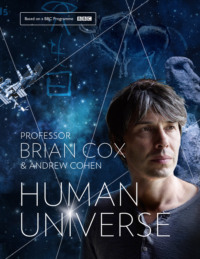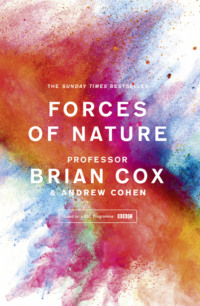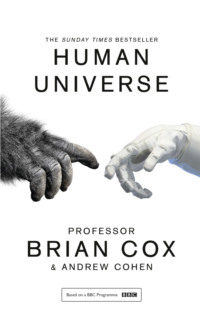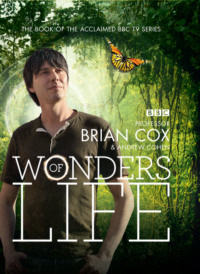
Полная версия
Wonders of the Solar System Text Only



TEXT ONLY EBOOK EDITION
For Gia, George and Mo, who kept our family together whilst I was away filming Wonders.
Brian Cox
For Anna, Benjamin, Martha and Theo, the true wonders of my solar system.
Andrew Cohen
Contents
Cover
Title Page






Index
Acknowledgements
Copyright
About the Publisher
CHAPTER 1

On a frosty winter’s afternoon the day after New Year 1959, a tiny metal sphere named First Cosmic Ship ascended, gently at first but with increasing ferocity, into a January sky above the Baikonur Cosmodrome a hundred miles east of the Aral Sea. Just a few minutes into her flight the little spacecraft separated from the third stage of her rocket and became the first man-made object to escape the gravitational grasp of planet Earth. On 4 January she passed by the Moon and entered a 450-day long orbit around the Sun somewhere between Earth and Mars, where she remains today. First Cosmic Ship, subsequently renamed Luna 1, is the oldest artificial planet and mankind’s first explorer of the Solar System.
Half a century later, we have launched an armada of robot emissaries and twenty-one human explorers beyond Earth’s gravitational grip and onwards to our neighbouring worlds. Five of our little craft have even escaped the gravitational embrace of the Sun on journeys that will ultimately take them to the stars. No longer confined to Earth, we now roam freely throughout the Empire of the Sun.
Our spacecraft have returned travellers’ tales and gifts beyond value; an explorer’s bounty that easily rivals the treasures, both material and intellectual, from the voyages of Magellan, Drake, Cook and their fellow navigators of Earth’s oceans. As with all exploration, the journeys have been costly and difficult, but the rewards are priceless.
Our first half-century of space exploration – less than a human lifetime – has revealed that our Solar System is truly a place of wonders. There are worlds beset with violence and dappled with oases of calm; worlds of fire and ice, searing heat and intense cold; planets with winds beyond the harshest of terrestrial hurricanes and moons with great sub-surface oceans of water. In one corner of the Sun’s empire there are planets where lead would flow molten across the surface, in another there are potential habitats for life beyond Earth. There are fountains of ice, volcanic plumes of sulphurous gases rising high into skies bathed in radiation and giant gas worlds ringed with pristine frozen water. A billion tiny worlds of rock and ice orbit our middle-aged yellowing Sun, stretching a quarter of the way to our nearest stellar neighbour, Proxima Centauri. What an empire of riches, and what a subject for a television series.
There are worlds of searing heat and intense cold; planets with winds beyond the harshest of terrestrial hurricanes and moons with great sub-surface oceans of water.
When we first began discussing making Wonders of the Solar System, we quickly realised that there is much more to the exploration of space than the spectacular imagery and surprising facts and figures returned by our robot spacefarers. Each mission has contributed new pieces to a subtle and complex jigsaw, and as the voyages have multiplied, a greatly expanded picture of the majestic arena within which we live our lives has been revealed. Mission by mission, piece by piece, we have learnt that our environment does not stop at the top of our atmosphere. The subtle and complex gravitational interactions of the planets with our Sun and the billions of lumps of rock and ice in orbit around it have directly influenced the evolution of the Earth over the 4.5 billion years since its formation, and that influence continues today.
Our moon, unusually large for a satellite in relation to its parent planet, is thought to stabilise our seasons and therefore may have played an important role in allowing complex life on Earth to develop; we probably need our moon.
It is thought that comets from the far reaches of the outer Solar System delivered much of the water in Earth’s oceans in a violent bombardment only half a billion years after our home planet formed. This event, known as the Late Heavy Bombardment, is thought to have been the result of an intense gravitational dance between the giant planets of our Solar System, Jupiter, Saturn and Neptune. Without this chance, violent intervention, there may have been little or no water on our planet; we probably need the comets, Jupiter, Saturn and Neptune.
More worryingly for us today, we have no reason to assume that this often-violent interaction with the other inhabitants of the Solar System has ceased; colossal lumps of rock and ice will visit us again from the distant vaults of the outer Solar System, and if undetected and unprepared for, we may not survive. It is thought that this very real threat is diminished by the gravitational influence of Jupiter on passing comets and asteroids, deflecting many of them out of our way; we probably need Jupiter.
This picture of the Solar System as a complex, interwoven and interacting environment stretching way beyond the top of our atmosphere is one of the central stories running throughout the series. In order to understand our place in space we must lift our eyes upwards from Earth’s horizon and gaze outwards across a vast sphere extending perhaps for a light year beyond the Kuiper belt of comets and onwards to the edge of the Oort cloud of ice-worlds surrounding the Sun.
Reaching for worlds beyond our grasp is an essential driver of progress and necessary sustenance for the human spirit. Curiosity is the rocket fuel that powers our civilization.
Our exploration of the Solar System has also given us very valuable insights into some of the most pressing and urgent problems we face today. Understanding the Earth’s complex weather and climate system, and how it responds to changes such as the increase of greenhouse gases in the atmosphere, is perhaps the greatest challenge for early twenty-first century science. This is a planetary science challenge: Earth is one example of a planet with an atmosphere of a particular chemical composition, orbiting the Sun at a particular distance. For a scientist, having only one example of such a vast and interdependent system is less than ideal, and makes the task of understanding its subtle and complex behaviour tremendously difficult. Fortunately, we do have more than one example. Our Solar System is a cosmic laboratory, a diverse collection of hundreds of worlds, large and small, hot and cold. Some orbit closer to our star than we do, most are vastly further away. Some have atmospheres rich in greenhouse gases, far denser than our own, others have lost all but faint traces of their atmospheres to the vacuum of space. Our two planetary neighbours, Venus and Mars, are salient examples of what can happen to worlds very similar to Earth if conditions are slightly different. Venus experienced a runaway greenhouse effect that raised its surface temperature to over 400 degrees Celsius and atmospheric pressure to ninety times that of Earth. Because the laws of physics that control the evolution of planetary atmospheres are the same on Earth and Venus, our understanding of the Greenhouse Effect on Earth can be transferred to and tested on Venus. This provides valuable additional information that can be used to tune and improve those models. The discovery that this benign, blue planet which shimmers brightly and with such beauty in the twilight skies of Earth was transformed long ago into a hellish world of searing temperatures, acid rain and crushing pressure has had a genuine and profound psychological effect because it demonstrates in stark terms that runaway greenhouse effects can happen to planets not too dissimilar from our own.
Similar salutary insights have accrued from our studies of Mars. In the early days of Mars exploration, observations of the evolution of dust storms on the red planet provided support for the nuclear winter hypothesis on Earth. Storms that began in small local areas were observed to throw large amounts of dust into the Martian atmosphere. Over a period of a few weeks, the dust encircled the entire planet, exactly matching the models of the evolution of the dust and smoke clouds that would be created by a large-scale nuclear exchange. When a planet is shrouded in dust, the warmth of the Sun is reflected back into space and temperatures quickly fall, leading to a so-called nuclear winter that could last many decades. On Earth, this could lead to the extinction of many species, including perhaps our own.
The observation of a mini-nuclear winter periodically playing itself out on Mars was a major factor in the acceptance of the theory, and this in turn profoundly influenced the thinking of major players at the end of the cold war. As former Russian president Mikhail Gorbachev said in 2000, ‘Models made by Russian and American scientists showed that a nuclear war would result in a nuclear winter that would be extremely destructive to all life on Earth; the knowledge of that was a great stimulus to us, to people of honor and morality, to act in that situation’.
Wonders is also a story of human ingenuity and engineering excellence. Russia’s First Cosmic Ship began its voyage beyond Earth just fifty-five years after the first powered flight by Orville and Wilbur Wright in December 1903. Wright Flyer 1 was constructed from spruce and muslin, and powered by a twelve-horsepower petrol engine assembled in a bicycle repair shop. By 1969, less than one human lifetime away, Armstrong and Aldrin set foot on another world, launched by a Saturn V rocket whose giant first-stage engines generated around 180 million horsepower between them. The most powerful and evocative flying machine ever built, the Moon rocket stood 111 metres (364 feet) high, just thirty centimetres (twelve inches) short of the dome of Wren’s magisterial St Paul’s Cathedral. Fully fuelled for a lunar voyage, it weighed 3,000 tonnes. Sixty-six years before Apollo 11’s half-a-million mile round trip to the Moon, Wright Flyer 1 reached an altitude of three metres (ten feet) on its maiden voyage. This rate of technological advancement, culminating with our first journeys into the deep Solar System, is surely unparalleled in human history, and the benefits are practically incalculable.
Most importantly of all, Wonders is a celebration of the spirit of exploration. This is desperately relevant, an idea so important that celebration is perhaps too weak a word. It is a plea for the spirit of the navigators of the seas and the pioneers of aviation and spaceflight to be restored and cherished; a case made to the viewer and reader that reaching for worlds beyond our grasp is an essential driver of progress and necessary sustenance for the human spirit. Curiosity is the rocket fuel that powers our civilization. If we deny this innate and powerful urge, perhaps because earthly concerns seem more worthy or pressing, then the borders of our intellectual and physical domain will shrink with our ambitions. We are part of a much wider ecosystem, and our prosperity and even long-term survival are contingent on our understanding of it.
‘Many years ago the great British explorer George Mallory, who was to die on Mount Everest, was asked why did he want to climb it. He said, “Because it is there.” Well, space is there, and we’re going to climb it, and the Moon and the planets are there, and new hopes for knowledge and peace are there. And, therefore, as we set sail we ask God’s blessing on the most hazardous and dangerous and greatest adventure on which man has ever embarked.’
— John F. Kennedy, Rice University 1962
In 1962, John F. Kennedy made one of the great political speeches at Rice University in Houston, Texas. In the speech, he argued the case for America’s costly and wildly ambitious conquest of the Moon. Imagine the bravado, the sheer power and confidence of vision in committing to a journey across a quarter of a million miles of space, landing on another world and returning safely to Earth. It might have been perceived as hubris at the time, but it worked. America achieved this most audacious feat of human ingenuity within nine years of launching their first manned sub-orbital flight. Next time you glance up at our shimmering satellite, give a thought to the human beings just like you who decided to go there and plant their flag for all mankind.
At the turn of the twenty-first century, the Solar System is our civilization’s frontier. Our first steps into the unexplored lands above our heads have been wildly successful, revealing a treasure chest of new worlds and giving us priceless insights into our planet’s unique beauty and fragility. As a species, we are constantly balanced on a knife-edge, prone to parochial disputes and unable to harness our powerful curiosity and boundless ingenuity. The exploration of the Solar System has brought out the best in us, and this is a precious gift. It rips away our worst instincts and forcibly thrusts us into a face-to-face encounter with the best. We are compelled to understand that we are one species amongst millions, living on one planet around one star amongst billions, inside one galaxy amongst trillions. The beauty of our planet is made manifest, enhanced immeasurably by the juxtaposition with other worlds. Ultimately, the value of young, curious and wonderful humanity as we take our first steps outwards from our home world is brought into such startling relief that all who share in the wonder must surely be filled with optimism and a powerful desire to continue this most valuable of journeys.
Конец ознакомительного фрагмента.
Текст предоставлен ООО «ЛитРес».
Прочитайте эту книгу целиком, купив полную легальную версию на ЛитРес.
Безопасно оплатить книгу можно банковской картой Visa, MasterCard, Maestro, со счета мобильного телефона, с платежного терминала, в салоне МТС или Связной, через PayPal, WebMoney, Яндекс.Деньги, QIWI Кошелек, бонусными картами или другим удобным Вам способом.









